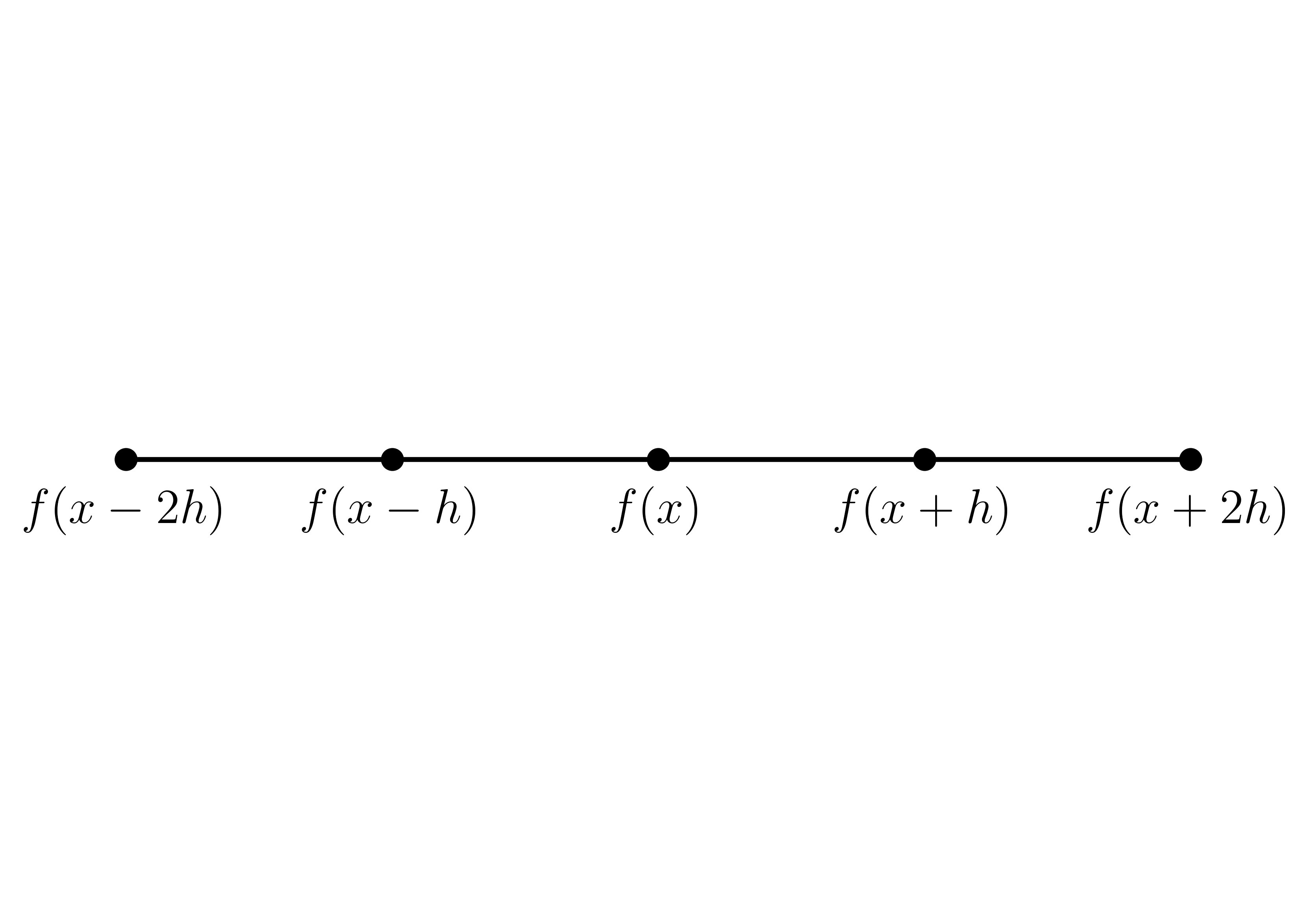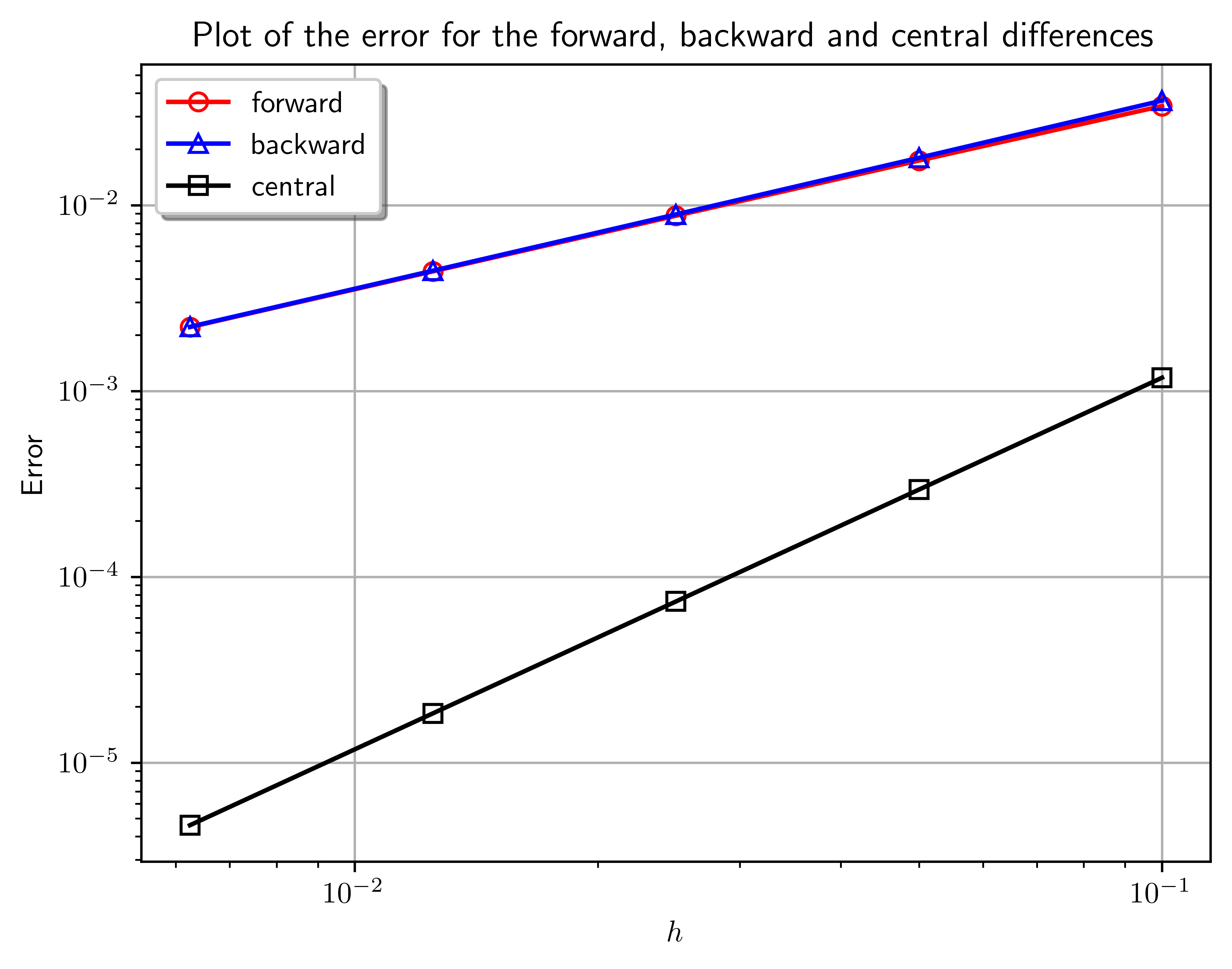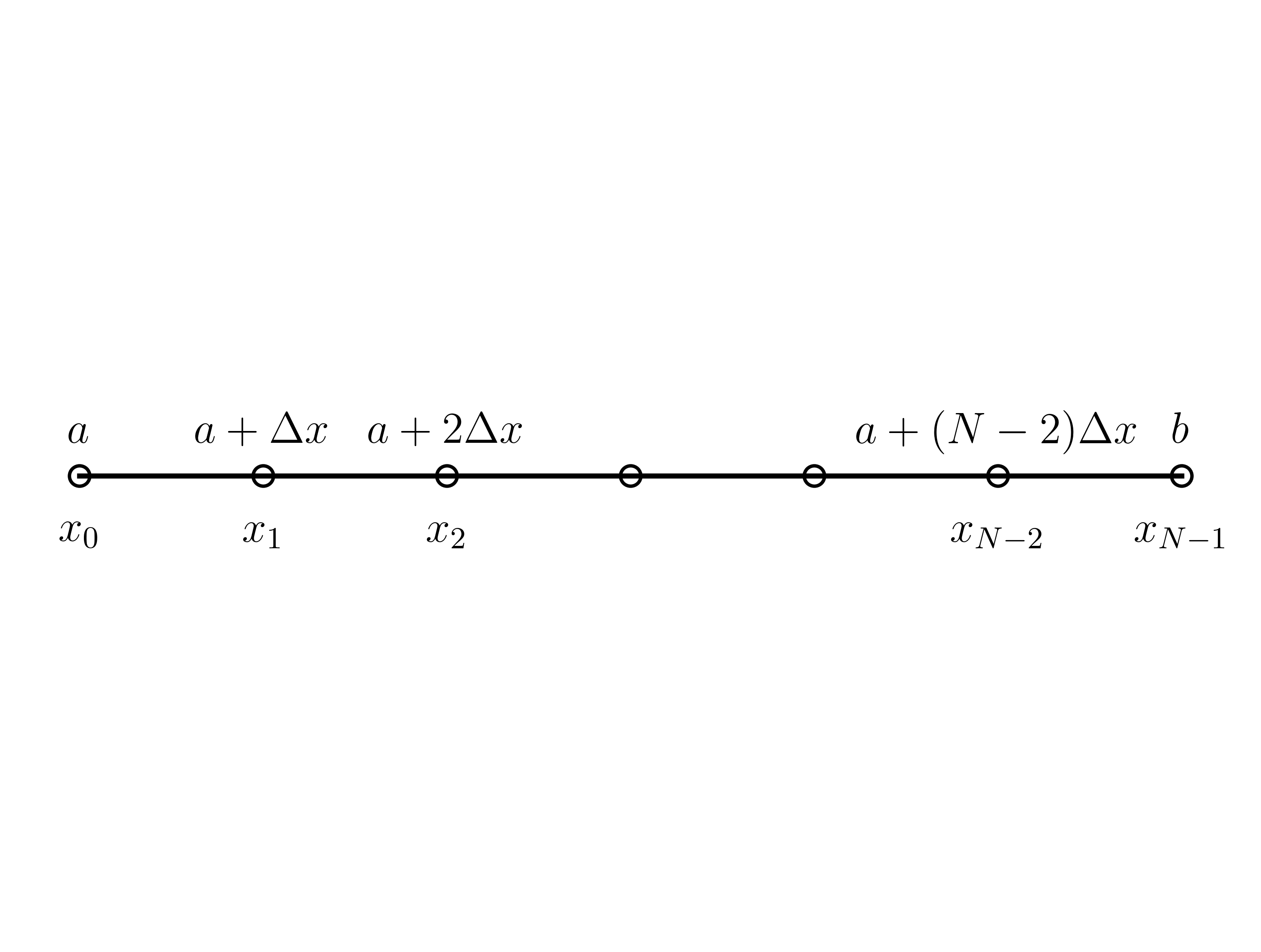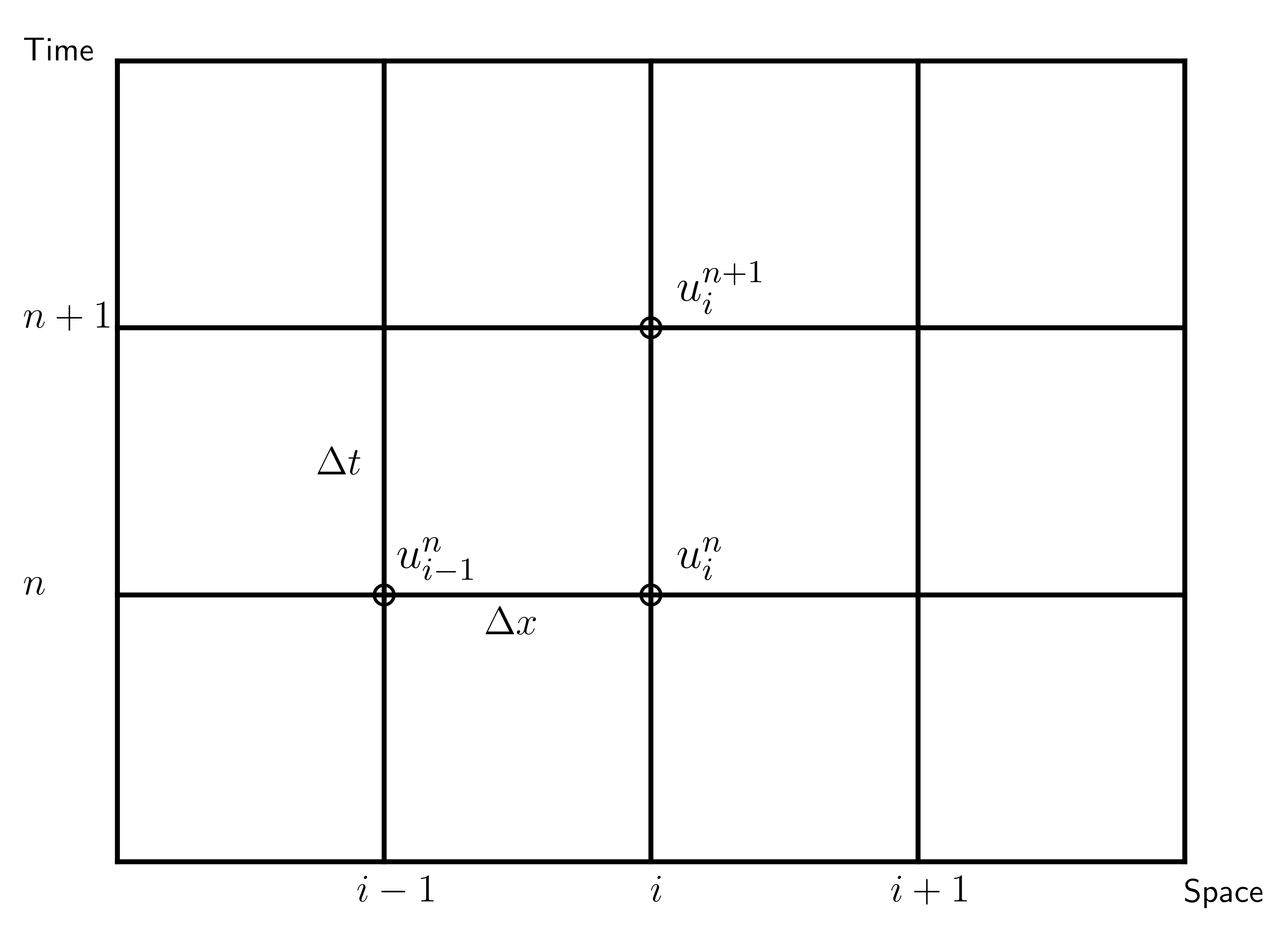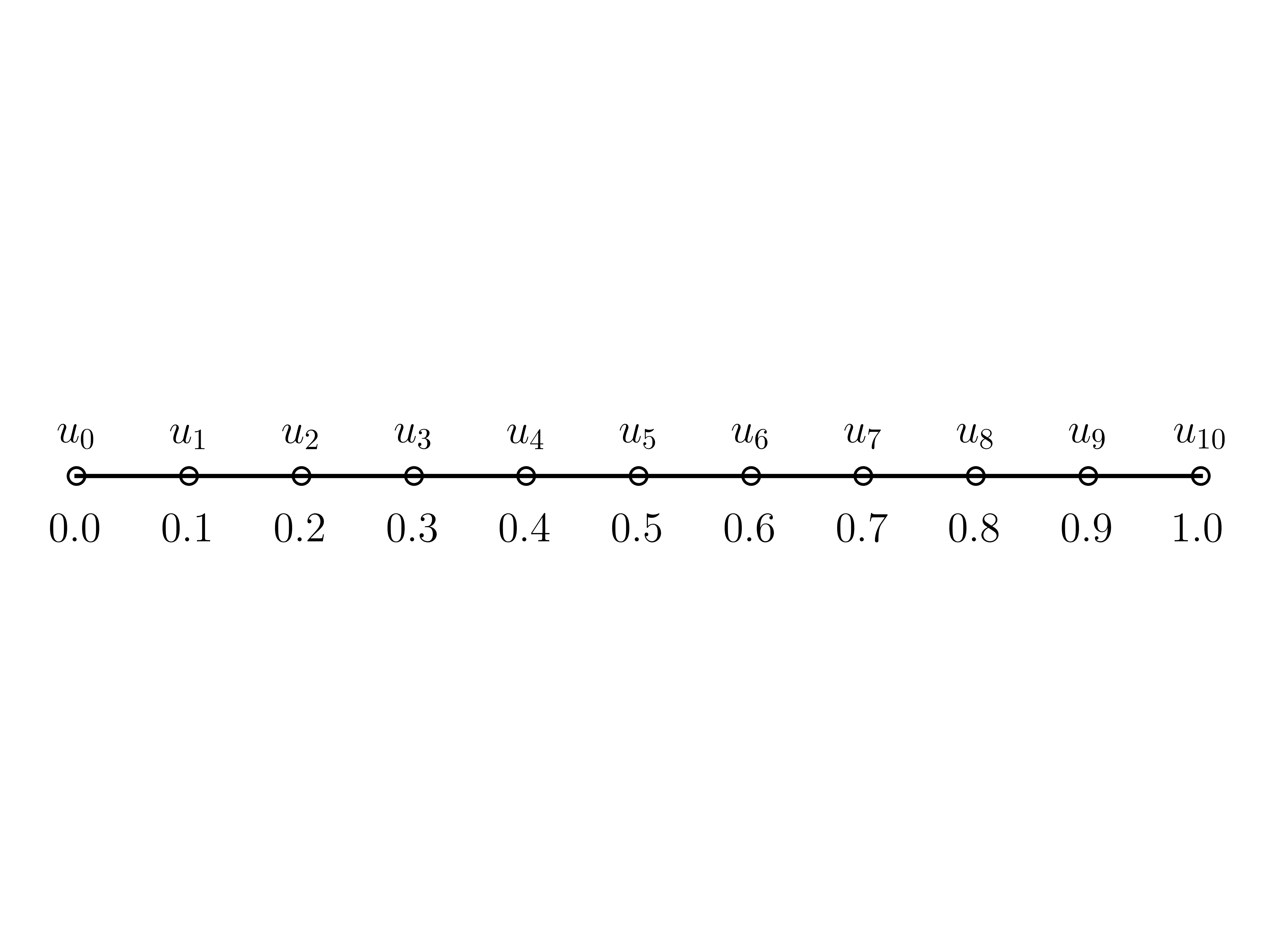2. Finite-Difference Approximations#
import matplotlib.pyplot as plt
import numpy as np
from helper import Approx, cleaner
from jaxtyping import Array, Float
from sympy import Derivative as D
from sympy import (
Eq,
Function,
Matrix,
O,
Symbol,
Wild,
cos,
solve,
solve_linear_system,
symbols,
)
from tabulate import tabulate
x = symbols("x")
h = symbols("h", positive=True)
f = Function("f")
2.1. They Taylor Series#
2.1.1. Forward Taylor Series#
Eq(f(x + h), f(x + h).series(x=h, x0=0, n=5).simplify())
\[\displaystyle f{\left(h + x \right)} = f{\left(x \right)} + h \frac{d}{d x} f{\left(x \right)} + \frac{h^{2} \frac{d^{2}}{d x^{2}} f{\left(x \right)}}{2} + \frac{h^{3} \frac{d^{3}}{d x^{3}} f{\left(x \right)}}{6} + \frac{h^{4} \frac{d^{4}}{d x^{4}} f{\left(x \right)}}{24} + O\left(h^{5}\right)\]
2.1.2. Backward Taylor Series#
Eq(f(x - h), f(x - h).series(x=h, x0=0, n=5).simplify())
\[\displaystyle f{\left(- h + x \right)} = f{\left(x \right)} - h \frac{d}{d x} f{\left(x \right)} + \frac{h^{2} \frac{d^{2}}{d x^{2}} f{\left(x \right)}}{2} - \frac{h^{3} \frac{d^{3}}{d x^{3}} f{\left(x \right)}}{6} + \frac{h^{4} \frac{d^{4}}{d x^{4}} f{\left(x \right)}}{24} + O\left(h^{5}\right)\]
2.1.3. Truncating the Taylor series#
2.1.4. Truncation error#
Approx(cos(x + h), cos(x + h).series(x=h, x0=0, n=2).removeO().simplify())
\[\displaystyle \cos{\left(h + x \right)} \approx - h \sin{\left(x \right)} + \cos{\left(x \right)}\]
x = 0
h = 0.1
exact = np.cos(x + h)
first_order_approximation = np.cos(x) - h * np.sin(x)
truncation_error = np.abs(exact - first_order_approximation)
E_h = np.abs(-(np.power(h, 2)) / 2 * np.cos(x))
print(
f"Truncation error: {truncation_error}\nE({h}): {E_h}\nError: {np.abs(truncation_error - E_h)}"
)
Truncation error: 0.0049958347219741794
E(0.1): 0.005000000000000001
Error: 4.165278025821534e-06
2.1.5. Plot#
h = np.flip(np.reciprocal(2 ** np.arange(1, 5).astype(float)))
x = 1
h
array([0.0625, 0.125 , 0.25 , 0.5 ])
error_truncation = np.abs(np.cos(x + h) - (np.cos(x) - h * np.sin(x)))
error_truncation
array([0.0010207 , 0.00394192, 0.0146122 , 0.04882961])
h_values = np.linspace(start=0, stop=h.max())
E_h = np.abs(-1 / 2 * h_values**2 * np.cos(x))
fig, ax = plt.subplots()
ax.plot(
h,
error_truncation,
"bo-",
label=r"Truncation error: $|\cos(x+h) - (\cos(x) - h\sin(x))|$",
)
ax.plot(h_values, E_h, "r--", label=r"$E(h)=|-\frac{1}{2}h^2\cos(1)|$")
ax.set_xlabel("$h$")
ax.set_ylabel("Truncation error")
ax.set_title("Truncation error plot")
ax.grid()
legend = ax.legend(loc="best", shadow=True)
2.2. Big-oh notation#
2.2.1. Expresing the truncation error as \(O\left(h^{n+1}\right)\)#
2.2.2. Properties of \(O\left(h^{n}\right)\)#
h = symbols("h")
m, n, k = (5, 2, -2)
assert m > n
k * O(h**n) == O(h**n)
True
O(h**m) + O(h**n) == O(h**n)
True
m, n = (2, 5)
assert m < n
O(h**n) / h**m == O(h ** (n - m))
True
2.3. Deriving finite-difference approximations#
x = np.arange(-2, 3)
fig, ax = plt.subplots()
ax.plot(x, np.zeros_like(x), "ko-")
ax.text(x[0], -0.008, rf"$f(x-2h)$", ha="center", fontsize=15)
ax.text(x[1], -0.008, rf"$f(x-h)$", ha="center", fontsize=15)
ax.text(x[2], -0.008, rf"$f(x)$", ha="center", fontsize=15)
ax.text(x[3], -0.008, rf"$f(x+h)$", ha="center", fontsize=15)
ax.text(x[-1], -0.008, rf"$f(x+2h)$", ha="center", fontsize=15)
ax.axes.get_xaxis().set_visible(False)
ax.axes.get_yaxis().set_visible(False)
ax.set_frame_on(False)
2.3.1. First-order accurate finite difference approximation of \(f_{x}\left(x\right)\)#
x = symbols("x")
h = symbols("h", positive=True)
f = Function("f")
Eq(f(x + h), f(x + h).series(x=h, x0=0, n=2).simplify())
\[\displaystyle f{\left(h + x \right)} = f{\left(x \right)} + h \frac{d}{d x} f{\left(x \right)} + O\left(h^{2}\right)\]
Eq(D(f(x)), solve(Eq(f(x + h), f(x + h).series(x=h, x0=0, n=2).simplify()), D(f(x)))[0])
\[\displaystyle \frac{d}{d x} f{\left(x \right)} = \frac{f{\left(h + x \right)} - f{\left(x \right)} + O\left(h^{2}\right)}{h}\]
2.3.2. First-order forward difference#
_ = f(x + h).series(x=h, x0=0, n=2).removeO().simplify()
forward_difference = Approx(D(f(x)), solve(Eq(_, f(x + h)), D(f(x)))[0])
forward_difference
\[\displaystyle \frac{d}{d x} f{\left(x \right)} \approx \frac{- f{\left(x \right)} + f{\left(h + x \right)}}{h}\]
Eq(f(x - h), f(x - h).series(x=h, x0=0, n=2).simplify())
\[\displaystyle f{\left(- h + x \right)} = f{\left(x \right)} - h \frac{d}{d x} f{\left(x \right)} + O\left(h^{2}\right)\]
Eq(D(f(x)), solve(Eq(f(x - h), f(x - h).series(x=h, x0=0, n=2).simplify()), D(f(x)))[0])
\[\displaystyle \frac{d}{d x} f{\left(x \right)} = \frac{- f{\left(- h + x \right)} + f{\left(x \right)} + O\left(h^{2}\right)}{h}\]
2.3.3. First-order backward difference#
_ = f(x - h).series(x=h, x0=0, n=2).removeO().simplify()
backward_difference = Approx(D(f(x)), solve(Eq(_, f(x - h)), D(f(x)))[0])
backward_difference
\[\displaystyle \frac{d}{d x} f{\left(x \right)} \approx \frac{f{\left(x \right)} - f{\left(- h + x \right)}}{h}\]
2.3.4. Second-order accurate finite difference approximation of \(f_{x}\left(x\right)\)#
Eq(f(x + h), f(x + h).series(x=h, x0=0, n=3).simplify())
\[\displaystyle f{\left(h + x \right)} = f{\left(x \right)} + h \frac{d}{d x} f{\left(x \right)} + \frac{h^{2} \frac{d^{2}}{d x^{2}} f{\left(x \right)}}{2} + O\left(h^{3}\right)\]
Eq(f(x - h), f(x - h).series(x=h, x0=0, n=3).simplify())
\[\displaystyle f{\left(- h + x \right)} = f{\left(x \right)} - h \frac{d}{d x} f{\left(x \right)} + \frac{h^{2} \frac{d^{2}}{d x^{2}} f{\left(x \right)}}{2} + O\left(h^{3}\right)\]
Eq(
f(x + h) - f(x - h),
f(x + h).series(x=h, x0=0, n=3).simplify()
- f(x - h).series(x=h, x0=0, n=3).simplify(),
)
\[\displaystyle - f{\left(- h + x \right)} + f{\left(h + x \right)} = 2 h \frac{d}{d x} f{\left(x \right)} + O\left(h^{3}\right)\]
2.3.5. Second-order central difference#
_ = f(x + h).series(x=h, x0=0, n=3).removeO().simplify()
__ = f(x - h).series(x=h, x0=0, n=3).removeO().simplify()
central_difference = Approx(
D(f(x), x), solve(Eq(_ - __, f(x + h) - f(x - h)), D(f(x), x))[0]
)
central_difference
\[\displaystyle \frac{d}{d x} f{\left(x \right)} \approx \frac{- f{\left(- h + x \right)} + f{\left(h + x \right)}}{2 h}\]
2.3.6. Second-order accurate finite difference approximation of \(f_{xx}\left(x\right)\)#
Eq(f(x + h), f(x + h).series(x=h, x0=0, n=4).simplify())
\[\displaystyle f{\left(h + x \right)} = f{\left(x \right)} + h \frac{d}{d x} f{\left(x \right)} + \frac{h^{2} \frac{d^{2}}{d x^{2}} f{\left(x \right)}}{2} + \frac{h^{3} \frac{d^{3}}{d x^{3}} f{\left(x \right)}}{6} + O\left(h^{4}\right)\]
Eq(f(x - h), f(x - h).series(x=h, x0=0, n=4).simplify())
\[\displaystyle f{\left(- h + x \right)} = f{\left(x \right)} - h \frac{d}{d x} f{\left(x \right)} + \frac{h^{2} \frac{d^{2}}{d x^{2}} f{\left(x \right)}}{2} - \frac{h^{3} \frac{d^{3}}{d x^{3}} f{\left(x \right)}}{6} + O\left(h^{4}\right)\]
Eq(
f(x + h) + f(x - h),
f(x + h).series(x=h, x0=0, n=4).simplify()
+ f(x - h).series(x=h, x0=0, n=4).simplify(),
)
\[\displaystyle f{\left(- h + x \right)} + f{\left(h + x \right)} = 2 f{\left(x \right)} + h^{2} \frac{d^{2}}{d x^{2}} f{\left(x \right)} + O\left(h^{4}\right)\]
2.3.7. Second-order symmetric difference#
_ = f(x + h).series(x=h, x0=0, n=4).removeO().simplify()
__ = f(x - h).series(x=h, x0=0, n=4).removeO().simplify()
symmetric_difference = Approx(
D(f(x), x, 2), solve(Eq(_ + __, f(x + h) + f(x - h)), D(f(x), x, 2))[0]
)
symmetric_difference
\[\displaystyle \frac{d^{2}}{d x^{2}} f{\left(x \right)} \approx \frac{- 2 f{\left(x \right)} + f{\left(- h + x \right)} + f{\left(h + x \right)}}{h^{2}}\]
cleaner(["x", "h", "f"])
Symbolic variables already cleared
2.3.8. Example \(3\)#
def forward_first_derivative(
f: np.ufunc, x: float, h: Float[Array, "dim1"]
) -> Float[Array, "dim1"]:
return (f(x + h) - f(x)) / h
def backward_first_derivative(
f: np.ufunc, x: float, h: Float[Array, "dim1"]
) -> Float[Array, "dim1"]:
return (f(x) - f(x - h)) / h
def central_first_derivative(
f: np.ufunc, x: float, h: Float[Array, "dim1"]
) -> Float[Array, "dim1"]:
return (f(x + h) - f(x - h)) / (2 * h)
def central_second_derivative(
f: np.ufunc, x: float, h: Float[Array, "dim1"]
) -> Float[Array, "dim1"]:
return (f(x + h) - 2 * f(x) + f(x - h)) / h**2
f = np.cos
f_prime = lambda x: -np.sin(x)
f_prime_prime = lambda x: -np.cos(x)
x = np.pi / 4
h = np.array(0.1)
exact_first_derivative = f_prime(x)
exact_second_derivative = f_prime_prime(x)
ffd = forward_first_derivative(f=f, x=x, h=h)
bfd = backward_first_derivative(f=f, x=x, h=h)
cfd = central_first_derivative(f=f, x=x, h=h)
csd = central_second_derivative(f=f, x=x, h=h)
print(
f"First derivative: {exact_first_derivative}\nForward first derivative: {ffd}\nBackward first derivative: {bfd}\
\nCentral first derivative: {cfd}\nSecond derivative: {exact_second_derivative}\nCentral second derivative: {csd}"
)
First derivative: -0.7071067811865475
Forward first derivative: -0.741254745095894
Backward first derivative: -0.6706029729039886
Central first derivative: -0.7059288589999413
Second derivative: -0.7071067811865476
Central second derivative: -0.7065177219190532
error_ffd = np.abs(exact_first_derivative - ffd)
error_bfd = np.abs(exact_first_derivative - bfd)
error_cfd = np.abs(exact_first_derivative - cfd)
error_csd = np.abs(exact_second_derivative - csd)
print(
f"Error forward first derivative: {error_ffd}\nError backward first derivative: {error_bfd}\
\nError central first derivative: {error_cfd}\nError central second derivative: {error_csd}"
)
Error forward first derivative: 0.03414796390934649
Error backward first derivative: 0.036503808282558836
Error central first derivative: 0.0011779221866061729
Error central second derivative: 0.0005890592674944184
2.3.9. Estimating the order of an approximation#
\[
n\approx
\dfrac{\log\left|E\left(h_{\max}\right)\right| -\log\left|E\left(h_{\min}\right)\right|}{
\log\left(h_{\max}\right)-\log\left(h_{\min}\right)
}.
\]
def estimate_order(
h: Float[Array, "dim1"], truncation_error: Float[Array, "dim1"]
) -> float:
assert h.size == truncation_error.size
Eh_max = truncation_error[np.argmax(h, axis=0)[0]][0]
Eh_min = truncation_error[np.argmin(h, axis=0)[0]][0]
return (np.log(np.abs(Eh_max)) - np.log(np.abs(Eh_min))) / (
np.log(h.max()) - np.log(h.min())
)
2.3.10. Table 2.1#
Finite-difference approximations of the first derivative of \(f\left(x\right)=\cos\left(x\right)\) at \(x=\dfrac{\pi}{4}\) using step lengths \(h\in\left\{0.1,0.05,0.25,0.0125,0.00625\right\}\).
f = np.cos
f_prime = lambda x: -np.sin(x)
x = np.pi / 4
h = np.reciprocal(10 * (2 ** np.arange(5).astype(float)))[np.newaxis].T
h
array([[0.1 ],
[0.05 ],
[0.025 ],
[0.0125 ],
[0.00625]])
forward = forward_first_derivative(f=f, x=x, h=h)
backward = backward_first_derivative(f=f, x=x, h=h)
central = central_first_derivative(f=f, x=x, h=h)
tabular = np.concatenate((h, forward, backward, central), axis=1)
header = ["h", "Forward", "Backward", "Central"]
print(
tabulate(tabular_data=tabular, headers=header, floatfmt=(".5e"))
) # TODO: As xarray.
h Forward Backward Central
----------- ------------ ------------ ------------
1.00000e-01 -7.41255e-01 -6.70603e-01 -7.05929e-01
5.00000e-02 -7.24486e-01 -6.89138e-01 -7.06812e-01
2.50000e-02 -7.15872e-01 -6.98195e-01 -7.07033e-01
1.25000e-02 -7.11508e-01 -7.02669e-01 -7.07088e-01
6.25000e-03 -7.09312e-01 -7.04892e-01 -7.07102e-01
print(f"{f_prime(x):.5e}")
-7.07107e-01
error_forward = np.abs(f_prime(x) - forward)
error_backward = np.abs(f_prime(x) - backward)
error_central = np.abs(f_prime(x) - central)
fig, ax = plt.subplots()
ax.loglog(h, error_forward, "ro-", mfc="none", label="forward")
ax.loglog(h, error_backward, "b^-", mfc="none", label="backward")
ax.loglog(h, error_central, "ks-", mfc="none", label="central")
ax.set_xlabel(r"$h$")
ax.set_ylabel(r"Error")
ax.set_title("Plot of the error for the forward, backward and central differences")
ax.grid()
legend = ax.legend(loc="best", shadow=True)
2.3.11. Table 2.2#
Truncation errors for the Taylor series approximations of \(\cos\left(1+h\right)\) for \(h\in\left\{0.5,0.25,0.125,0.0625\right\}\).
f = lambda h: np.cos(1 + h)
f_prime = lambda h: -np.sin(1 + h)
x = 1
h = np.reciprocal(2 ** np.arange(1, 5).astype(float))[np.newaxis].T
h
array([[0.5 ],
[0.25 ],
[0.125 ],
[0.0625]])
forward = forward_first_derivative(f=f, x=x, h=h)
backward = backward_first_derivative(f=f, x=x, h=h)
central = central_first_derivative(f=f, x=x, h=h)
error_forward = np.abs(f_prime(x) - forward)
error_backward = np.abs(f_prime(x) - backward)
error_central = np.abs(f_prime(x) - central)
tabular = np.concatenate((h, error_forward, error_backward, error_central), axis=1)
header = ["h", "Forward error", "Backward error", "Central error"]
print(tabulate(tabular_data=tabular, headers=header, floatfmt=(".5e")))
h Forward error Backward error Central error
----------- --------------- ---------------- ---------------
5.00000e-01 1.39304e-01 6.44706e-02 3.74166e-02
2.50000e-01 6.11903e-02 4.23057e-02 9.44229e-03
1.25000e-01 2.83414e-02 2.36092e-02 2.36611e-03
6.25000e-02 1.35922e-02 1.24085e-02 5.91875e-04
estimate_order(h, error_forward)
np.float64(1.1191270541574243)
estimate_order(h, error_backward)
np.float64(0.7924386666069776)
estimate_order(h, error_central)
np.float64(1.9940809174948577)
2.3.12. Finite-difference approximations of mixed derivatives#
x, y = symbols("x y")
dx = Symbol(r"\Delta x")
dy = Symbol(r"\Delta y")
f = Function("f")
arg1, arg2 = Wild("arg1"), Wild("arg2")
_ = Approx(f(x + dx, y), f(x + dx, y).series(x=dx, x0=0, n=2).removeO().simplify())
__ = Approx(f(x, y + dy), f(x, y + dy).series(x=dy, x0=0, n=2).removeO().simplify())
Eq1 = Approx(D(f(x, y), x), solve(_, D(f(x, y), x))[0])
Eq2 = Approx(D(f(x, y), y), solve(__, D(f(x, y), y))[0])
Eq1
\[\displaystyle \frac{\partial}{\partial x} f{\left(x,y \right)} \approx \frac{- f{\left(x,y \right)} + f{\left(\Delta x + x,y \right)}}{\Delta x}\]
Eq2
\[\displaystyle \frac{\partial}{\partial y} f{\left(x,y \right)} \approx \frac{- f{\left(x,y \right)} + f{\left(x,\Delta y + y \right)}}{\Delta y}\]
Approx(
D(D(f(x, y), y), x),
Eq1.rhs.replace(f(arg1, arg2), D(f(arg1, arg2), arg2)),
)
\[\displaystyle \frac{\partial^{2}}{\partial x\partial y} f{\left(x,y \right)} \approx \frac{- \frac{\partial}{\partial y} f{\left(x,y \right)} + \frac{\partial}{\partial y} f{\left(\Delta x + x,y \right)}}{\Delta x}\]
Approx(
D(D(f(x, y), y), x),
Eq1.rhs.replace(f(arg1, arg2), D(f(arg1, arg2), arg2)).subs(
{
D(f(x + dx, y), y): Eq2.rhs.replace(f(arg1, arg2), f(arg1 + dx, arg2)),
D(f(x, y), y): Eq2.rhs,
}
),
)
\[\displaystyle \frac{\partial^{2}}{\partial x\partial y} f{\left(x,y \right)} \approx \frac{- \frac{- f{\left(x,y \right)} + f{\left(x,\Delta y + y \right)}}{\Delta y} + \frac{- f{\left(\Delta x + x,y \right)} + f{\left(\Delta x + x,\Delta y + y \right)}}{\Delta y}}{\Delta x}\]
Approx(
D(D(f(x, y), y), x),
((Eq2.rhs.replace(f(arg1, arg2), f(arg1 + dx, arg2)) - Eq2.rhs) / dx).simplify(),
)
\[\displaystyle \frac{\partial^{2}}{\partial x\partial y} f{\left(x,y \right)} \approx \frac{f{\left(x,y \right)} - f{\left(x,\Delta y + y \right)} - f{\left(\Delta x + x,y \right)} + f{\left(\Delta x + x,\Delta y + y \right)}}{\Delta x \Delta y}\]
2.3.13. Deriving finite-difference formulae using the method of undetermined coefficients#
c_1, c_2, c_3, x, h = symbols("c_1 c_2 c_3 x h")
f_n = Function("f_{(n)}")
Eq(f_n(x), c_1 * f(x - h) + c_2 * f(x) + c_3 * f(x + h))
\[\displaystyle f_{(n)}{\left(x \right)} = c_{1} f{\left(- h + x \right)} + c_{2} f{\left(x \right)} + c_{3} f{\left(h + x \right)}\]
Eq(
f_n(x),
(
c_1 * f(x - h).series(x=h, x0=0, n=3).simplify()
+ c_2 * f(x)
+ c_3 * f(x + h).series(x=h, x0=0, n=3).simplify()
).simplify(),
)
\[\displaystyle f_{(n)}{\left(x \right)} = c_{3} f{\left(x \right)} + c_{3} h \frac{d}{d x} f{\left(x \right)} + \frac{c_{3} h^{2} \frac{d^{2}}{d x^{2}} f{\left(x \right)}}{2} + c_{2} f{\left(x \right)} + c_{1} f{\left(x \right)} - c_{1} h \frac{d}{d x} f{\left(x \right)} + \frac{c_{1} h^{2} \frac{d^{2}}{d x^{2}} f{\left(x \right)}}{2} + O\left(h^{3}\right)\]
solve_linear_system(
Matrix(((1, 1, 1, 0), (-1, 0, 1, 1 / h), (1, 0, 1, 0))), c_1, c_2, c_3
)
{c_1: -1/(2*h), c_2: 0, c_3: 1/(2*h)}
solve_linear_system(
Matrix(((1, 1, 1, 0), (-1, 0, 1, 0), (1, 0, 1, 2 / h**2))), c_1, c_2, c_3
)
{c_1: h**(-2), c_2: -2/h**2, c_3: h**(-2)}
2.3.14. Example 4#
Eq(f_n(x), c_1 * f(x) + c_2 * f(x + h) + c_3 * f(x + 2 * h))
\[\displaystyle f_{(n)}{\left(x \right)} = c_{1} f{\left(x \right)} + c_{2} f{\left(h + x \right)} + c_{3} f{\left(2 h + x \right)}\]
f(x + 2 * h).series(x=2 * h, x0=0, n=3).simplify()
\[\displaystyle f{\left(x \right)} + 2 h \frac{d}{d x} f{\left(x \right)} + 2 h^{2} \frac{d^{2}}{d x^{2}} f{\left(x \right)} + O\left(h^{3}\right)\]
Eq(
f_n(x),
(
c_1 * f(x)
+ c_2 * f(x + h).series(x=h, x0=0, n=3).simplify()
+ c_3 * f(x + 2 * h).series(x=2 * h, x0=0, n=3).simplify()
).simplify(),
)
\[\displaystyle f_{(n)}{\left(x \right)} = c_{3} f{\left(x \right)} + 2 c_{3} h \frac{d}{d x} f{\left(x \right)} + 2 c_{3} h^{2} \frac{d^{2}}{d x^{2}} f{\left(x \right)} + c_{2} f{\left(x \right)} + c_{2} h \frac{d}{d x} f{\left(x \right)} + \frac{c_{2} h^{2} \frac{d^{2}}{d x^{2}} f{\left(x \right)}}{2} + c_{1} f{\left(x \right)} + O\left(h^{3}\right)\]
solve_linear_system(
Matrix(((1, 1, 1, 0), (0, 1, 2, 1 / h), (0, 1 / 2, 2, 0))), c_1, c_2, c_3
)
{c_1: -1.5/h, c_2: 2.0/h, c_3: -0.5/h}
2.4. The finite-difference toolkit#
t, x = symbols("t x")
dt = Symbol(r"\Delta t")
dx = Symbol(r"\Delta x")
f = Function("f")
_ = f(t, x + dx).series(x=dx, x0=0, n=2).removeO().simplify()
__ = f(t, x - dx).series(x=dx, x0=0, n=2).removeO().simplify()
Approx(D(f(t, x), x), solve(Eq(_ - __, f(t, x + dx) - f(t, x - dx)), D(f(t, x), x))[0])
\[\displaystyle \frac{\partial}{\partial x} f{\left(t,x \right)} \approx \frac{- f{\left(t,- \Delta x + x \right)} + f{\left(t,\Delta x + x \right)}}{2 \Delta x}\]
_ = f(t + dt, x).series(x=dt, x0=0, n=2).removeO().simplify()
__ = f(t - dt, x).series(x=dt, x0=0, n=2).removeO().simplify()
Approx(D(f(t, x), t), solve(Eq(_ - __, f(t + dt, x) - f(t - dt, x)), D(f(t, x), t))[0])
\[\displaystyle \frac{\partial}{\partial t} f{\left(t,x \right)} \approx \frac{- f{\left(- \Delta t + t,x \right)} + f{\left(\Delta t + t,x \right)}}{2 \Delta t}\]
2.5. Finite-Difference Toolkit#
# Eq(D(f(x), x, 4), 0)
2.6. Example of a finite difference scheme#
Let \(U\left(t,x\right)\) the concentration of some substance and \(v\) is the speed that the substance travels along \(a\leq x\leq b\).
\[\begin{split}
\begin{cases}
U_{t}+v U_{x}=0
& \text { for }a\leq x\leq b, t>0. \\
U
\left(0, x\right)=
f\left(x\right)
& \text { for }a\leq x\leq b. \\
U
\left(t, a\right)=
U\left(t, b\right)=0
& \text { for }t>0. \\
\end{cases}
\end{split}\]
2.6.1. Spatial discretization#
In a uniform grid, the \(i\)-th node in the grid is located at \(x_{i}=a+i\Delta x\).
\[
\Delta x=
\dfrac{b-a}{N-1}.
\]
x = np.arange(-3, 4)
fig, ax = plt.subplots()
ax.plot(x, np.zeros_like(x), "ko-", mfc="none")
ax.text(x[0], 0.004, rf"$a$", ha="center", fontsize=13)
ax.text(x[0], -0.008, rf"$x_0$", ha="center", fontsize=13)
ax.text(x[1], 0.004, rf"$a+\Delta x$", ha="center", fontsize=13)
ax.text(x[1], -0.008, rf"$x_1$", ha="center", fontsize=13)
ax.text(x[2], 0.004, rf"$a+2\Delta x$", ha="center", fontsize=13)
ax.text(x[2], -0.008, rf"$x_2$", ha="center", fontsize=13)
ax.text(x[-2], 0.004, rf"$a+(N-2)\Delta x$", ha="center", fontsize=13)
ax.text(x[-2], -0.008, rf"$x_{{N-2}}$", ha="center", fontsize=13)
ax.text(x[-1], 0.004, rf"$b$", ha="center", fontsize=13)
ax.text(x[-1], -0.008, rf"$x_{{N-1}}$", ha="center", fontsize=13)
ax.axes.get_xaxis().set_visible(False)
ax.axes.get_yaxis().set_visible(False)
ax.set_frame_on(False)
2.7. Deriving a finite-difference scheme#
\[\begin{split}
\begin{aligned}
U_{t}+vU_{x}&=0\\
\dfrac{U^{n+1}_{i}-U^{n}_{i}}{\Delta t}+
v\dfrac{U^{n}_{i}-U^{n}_{i-1}}{\Delta x}
&=0.\\
U^{n+1}_{i}
&=
U^{n}_{i}-
\dfrac{v\Delta t}{\Delta x}
\left(U^{n}_{i}-U^{n}_{i-1}\right).
\end{aligned}
\end{split}\]
v = symbols("v")
fig = plt.figure()
for i in range(4):
plt.plot((0, 4), (i, i), "k")
for j in range(5):
plt.plot((j, j), (0, 3), "k")
plt.plot(2, 2, "ko", mfc="none")
plt.plot(2, 1, "ko", mfc="none")
plt.plot(1, 1, "ko", mfc="none")
ax = fig.gca()
ax.axis("off")
ax.axis("equal")
plt.text(0.9, -0.15, "$i-1$", fontsize=12)
plt.text(2, -0.15, "$i$", fontsize=12)
plt.text(2.9, -0.15, "$i+1$", fontsize=12)
plt.text(2.1, 1.1, "$u^n_i$", fontsize=14)
plt.text(2.1, 2.1, "$u^{n+1}_i$", fontsize=14)
plt.text(1.05, 1.1, "$u^{n}_{i-1}$", fontsize=14)
plt.text(1.38, 0.85, r"$\Delta x$", fontsize=12)
plt.text(0.75, 1.45, r"$\Delta t$", fontsize=12)
plt.text(-0.35, 1, "$n$", fontsize=12)
plt.text(-0.35, 2, "$n+1$", fontsize=12)
plt.text(-0.35, 3, "Time")
plt.text(4, -0.15, "Space");
2.7.1. Computational and boundary nodes#
t, x, a, b = symbols("t x a b")
U = Function("U")
Eq(U(t, a), 0)
\[\displaystyle U{\left(t,a \right)} = 0\]
Eq(U(t, b), 0)
\[\displaystyle U{\left(t,b \right)} = 0\]
N = 11 # number of nodes
number_iterations = 3
x, dx = np.linspace(start=0, stop=1, num=N, retstep=True) # node positions
v = 1 # speed
dt = 0.05 # time step
t = 0 # initial value of t
fig, ax = plt.subplots()
fig.set_tight_layout(True)
ax.plot(x, np.zeros_like(x), "ko-", mfc="none")
# ax.set_xlabel(r"$x_{i}$")
for i, xi in enumerate(x):
ax.text(xi, 0.004, rf"$u_{{{i}}}$", ha="center", fontsize=15)
ax.text(xi, -0.008, rf"${{{np.round(xi, 2)}}}$", ha="center", fontsize=15)
ax.axes.get_xaxis().set_visible(False)
ax.axes.get_yaxis().set_visible(False)
ax.set_frame_on(False)
C = v * dt / dx
U = np.empty((number_iterations + 1, x.size))
U[0, :] = np.exp(-100 * np.power(x - 0.4, 2)) # initial conditions
U[0, 0], U[0, -1] = (0, 0)
for n in range(number_iterations):
U[n + 1, 0], U[n + 1, -1] = (0, 0) # boundary nodes
for i in range(x.size):
U[n + 1, i] = U[n, i] - C * (U[n, i] - U[n, i - 1])
# Values of the first three iterations of the FDS used to solve the advection equation
tabular = np.hstack(
(
np.array(["i", "x_i", "u^0_i", "u^1_i", "u^2_i", "u^3_i"])[np.newaxis].T,
np.vstack((np.arange(x.size)[np.newaxis], x, U)),
)
)
print(tabulate(tabular, floatfmt=".4f"))
----- ------ ------ ------ ------ ------ ------ ------ ------ ------ ------ -------
i 0.0000 1.0000 2.0000 3.0000 4.0000 5.0000 6.0000 7.0000 8.0000 9.0000 10.0000
x_i 0.0000 0.1000 0.2000 0.3000 0.4000 0.5000 0.6000 0.7000 0.8000 0.9000 1.0000
u^0_i 0.0000 0.0001 0.0183 0.3679 1.0000 0.3679 0.0183 0.0001 0.0000 0.0000 0.0000
u^1_i 0.0000 0.0001 0.0092 0.1931 0.6839 0.6839 0.1931 0.0092 0.0001 0.0000 0.0000
u^2_i 0.0000 0.0000 0.0046 0.1012 0.4385 0.6839 0.4385 0.1012 0.0046 0.0000 0.0000
u^3_i 0.0000 0.0000 0.0023 0.0529 0.2698 0.5612 0.5612 0.2698 0.0529 0.0023 0.0000
----- ------ ------ ------ ------ ------ ------ ------ ------ ------ ------ -------
with np.printoptions(precision=5, suppress=True):
print(np.array([np.pi]))
[3.14159]


